Nairobi, the vibrant capital of Kenya, offers a captivating blend of rich culture, modern living, and extraordinary wildlife experiences. Often dubbed the ‘Safari Capital of the World,’ Nairobi’s unique placement has elevated it as a must-visit tourist destination, making it an essential stop on any African journey.
If you’re planning to explore Nairobi, here are the top places you can visit.
Nairobi National Park

Photo Credit: Trip Advisor
Uniquely positioned within a bustling city, Nairobi National Park offers a one-of-a-kind wilderness experience. Established in 1946, the park is Kenya’s first national park and a testament to the country’s committed conservation efforts.
Spanning an area of approximately 117 square kilometers (45 square miles), Nairobi National Park is located about 7 kilometers (4 miles) south of Nairobi’s city center. This proximity to the urban landscape makes it the only national park globally that has a city’s skyline as its backdrop. Its higher altitude, between 1,533 and 1,760 meters, gives it a fairly cool climate compared to other regions in Kenya.
Despite its relatively small size, the park boasts a vast and diverse range of wildlife. It is home to over 100 mammal species, including lions, leopards, hyenas, cheetahs, giraffes, zebras, and buffalos. The park is also an important refuge for black rhinos and is considered one of the most successful rhinoceros sanctuaries.
One of the park’s notable features is its substantial wildebeest and zebra migration, offering a mini “migration” spectacle, usually around July and August, akin to the more famous Great Migration in the Maasai Mara.
The park also provides a habitat for over 400 bird species, both migratory and endemic. It is, therefore, not just a paradise for mammal enthusiasts but bird watchers as well.
Within the park, the David Sheldrick Wildlife Trust serves as a sanctuary for orphaned elephants and rhinos, offering visitors a unique opportunity to learn about conservation efforts for these magnificent creatures.
A visit to the Nairobi National Park provides an incredible opportunity to experience a rich diversity of flora and fauna with the convenience of being in close proximity to a major city. It is a remarkable testament to Nairobi’s commitment to wildlife conservation, living up to its nickname as the “wildlife capital of the world.”
Regenerate response
ChatGPT may
David Sheldrick Wildlife Trust
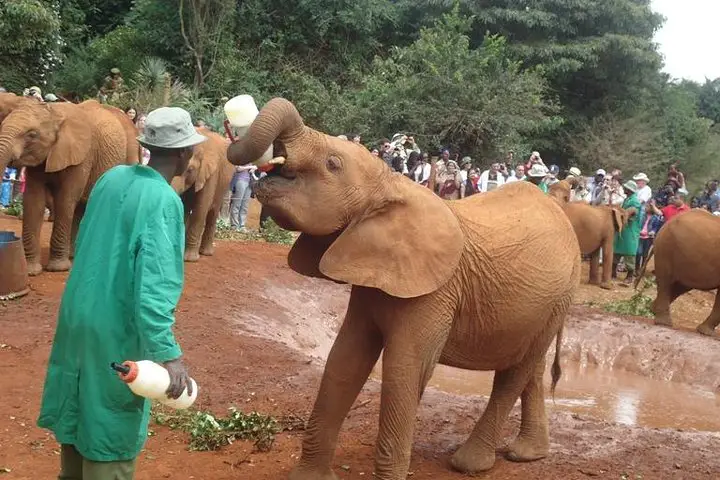
Photo Credit: Trip Advisor
The David Sheldrick Wildlife Trust (DSWT) is a haven for orphaned elephants and rhinos, and it’s located within Nairobi National Park. Established in 1977 by Dr. Dame Daphne Sheldrick, in memory of her late husband, David Sheldrick, a renowned naturalist and the founding warden of Tsavo East National Park, the trust has successfully hand-reared over 150 infant elephants and reintegrated them into the wild herds of Tsavo.
One of the significant efforts of DSWT is rescuing and nurturing orphaned elephants and rhinos who have lost their mothers due to poaching, drought, or human-wildlife conflict. The caretakers at the trust provide round-the-clock care to these young ones, offering not just food and medical care, but also the love and emotional support these animals need to thrive.
The trust has pioneered numerous conservation techniques, particularly in the raising of infant elephants and rhinos. This includes the development of a special milk formula and husbandry techniques that cater to these orphans’ needs.
Visitors to the trust can watch the feeding of these magnificent creatures and witness their playful antics during the daily mud bath. Moreover, people can learn about conservation efforts and the threats facing these species. This serves as a unique educational opportunity, especially for children, to learn about wildlife conservation.
One of the trust’s most popular initiatives is the adoption program, where individuals can sponsor an elephant or rhino. The funds from this program directly contribute to conservation efforts, including anti-poaching teams and mobile veterinary units. This allows visitors and supporters worldwide to form an emotional connection with these animals and contribute actively to their well-being.
In conclusion, the David Sheldrick Wildlife Trust plays a crucial role in wildlife conservation and is a testament to humanity’s capacity to positively influence the natural world. A visit to the trust not only offers a heartwarming experience but also provides insight into critical conservation work.
Nairobi National Museum

The Nairobi National Museum is a gem in Kenya’s cultural and historical landscape. Located on Museum Hill, just a few minutes’ drive from Nairobi’s city center, it offers visitors a deep dive into the country’s rich and diverse heritage.
Established in 1929, the museum underwent significant renovations and reopened in 2008, revealing modern and more expansive exhibits. The museum is operated by the National Museums of Kenya, a government organization tasked with preserving the country’s historical and cultural artifacts.
The Nairobi National Museum is broadly divided into four primary sections: Palaeontology, Ethnography, Art, and Natural History.
The palaeontology section showcases prehistoric artifacts and fossils discovered within Kenya, including the famous Turkana Boy, the nearly complete skeleton of a Homo habilis. These fossils trace back human evolution, solidifying Kenya’s reputation as the “Cradle of Mankind.”
The ethnography section explores Kenya’s cultural diversity, showcasing artifacts from different ethnic groups. It includes traditional attire, musical instruments, tools, and crafts. This exhibit offers a deeper understanding of the country’s cultural traditions and practices.
The museum features a range of art exhibits, from contemporary art to historical pieces. It hosts regular exhibitions showcasing the works of local and international artists.
The natural history section displays a wide range of flora and fauna, providing insights into the country’s diverse ecosystems. From birds, mammals, and reptiles to insects and botanical displays, it offers an educational exploration of Kenya’s natural wealth.
The museum also boasts a botanical garden and a nature trail, offering a peaceful retreat for visitors. The museum’s architecture and landscaping are themselves worth noting, featuring contemporary African design.
Moreover, it houses the Louis Leakey auditorium, where lectures, concerts, and film screenings are often held. The museum also includes a shopping center and a restaurant, providing a complete recreational and educational outing for visitors.
In essence, the Nairobi National Museum is not just a museum but a celebration of Kenya’s past, present, and future. It offers a unique opportunity to delve into the country’s rich history, diverse cultures, and its natural splendor, making it a must-visit destination for anyone visiting Nairobi.
Giraffe Centre
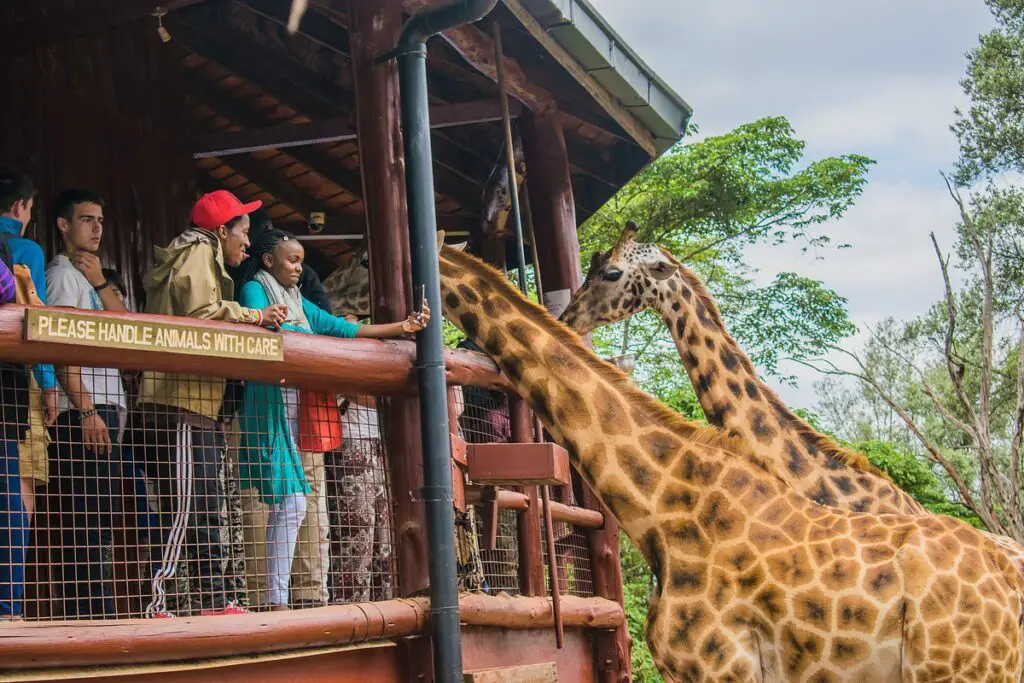
Photo Credit: Trip Advisor
The Giraffe Centre, located in Lang’ata, just outside of Nairobi’s city center, is a unique conservation project and one of the city’s most popular tourist destinations. It was established by the African Fund for Endangered Wildlife (A.F.E.W.) in 1983 as a response to the endangered status of the Rothschild giraffe. The main goal of the center is to provide conservation education for Kenyan youth and to protect and breed Rothschild giraffes before reintroducing them into the wild.
The Giraffe Centre gives visitors the unique opportunity to come into close contact with these magnificent creatures. A raised platform allows visitors to feed the giraffes with specially provided pellets, offering an up-close encounter that you would rarely experience in the wild. It’s a particular treat to see their long, prehensile tongues in action, extending up to 20 inches to grasp food.
In addition to the resident giraffes, the center is also home to several warthogs, and over a hundred bird species can be spotted within the grounds. The center offers a self-guided forest walk through the adjacent Gogo River Bird Sanctuary for those looking to explore the local flora and fauna further.
The Giraffe Centre runs a robust environmental education program for Kenyan school children, offering them free conservation education. Over the years, the center has significantly contributed to increasing the population of Rothschild giraffes in Kenya.
Moreover, the center houses a comprehensive information center where visitors can learn about giraffe conservation and the various challenges these animals face in the wild. There’s also a small gift shop selling giraffe-themed souvenirs, with proceeds supporting the center’s conservation efforts.
Whether you’re a nature enthusiast, a wildlife lover, or traveling with children, the Giraffe Centre in Nairobi offers a unique, hands-on wildlife experience, coupled with educational opportunities that make it a memorable visit. It is a testament to how wildlife conservation efforts can successfully help protect and increase populations of endangered species.
Kazuri Beads Women Cooperative
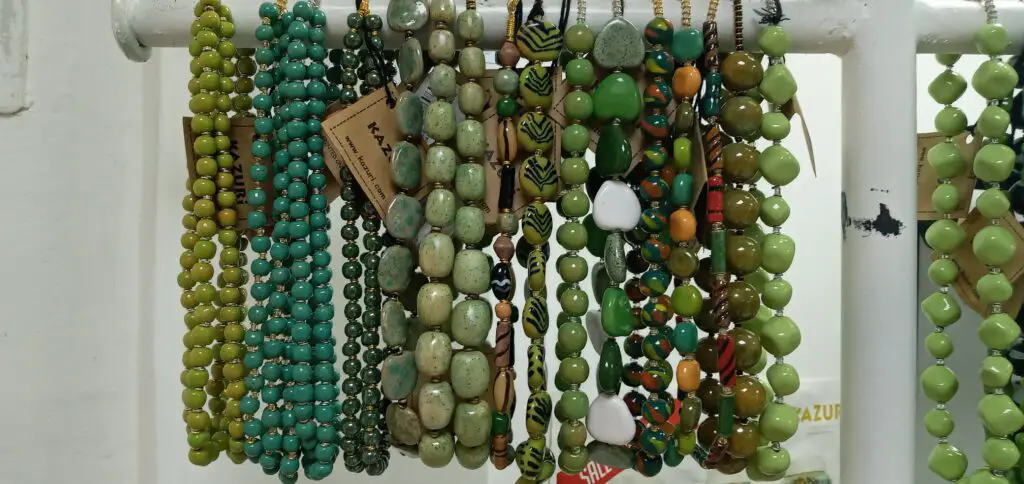
The Kazuri Beads Women Cooperative, located in the Karen suburb of Nairobi, is an uplifting success story of women empowerment, entrepreneurship, and craftsmanship. Founded in 1975 by the late Lady Susan Wood, the cooperative started with just two employees and a simple mission – to provide sustainable employment opportunities for struggling single mothers.
The name “Kazuri” translates to “small and beautiful” in Swahili, encapsulating the essence of the exquisite ceramic beads and pottery they create. Today, Kazuri Beads employs over 300 women, providing not only a stable income but also a sense of community and empowerment. Each bead is hand-shaped from clay, kiln-fired, painted, and then fired again, resulting in vibrant, high-quality beads. This labor-intensive process makes every bead and every piece of jewelry unique.
Visitors to the Kazuri Beads Women Cooperative have the opportunity to take a guided tour of the workshop, where they can witness the bead-making process from start to finish. From the molding of the clay to the meticulous hand painting, the tour provides an insight into the level of craftsmanship that goes into each bead.
The cooperative also has a store on-site where visitors can purchase jewelry, pottery, and other items made by the women. Each purchase directly supports the women artisans and their families, contributing to their economic independence and the overall well-being of the community.
Kazuri Beads are now sold internationally, with their products available in Europe, Australia, and the United States. The cooperative is a member of the World Fair Trade Organization, ensuring that their practices align with fair trade principles.
A visit to the Kazuri Beads Women Cooperative offers a unique opportunity to witness the transformative power of community, creativity, and entrepreneurship, making it a must-visit destination in Nairobi for those interested in socially conscious tourism.
Maasai Market
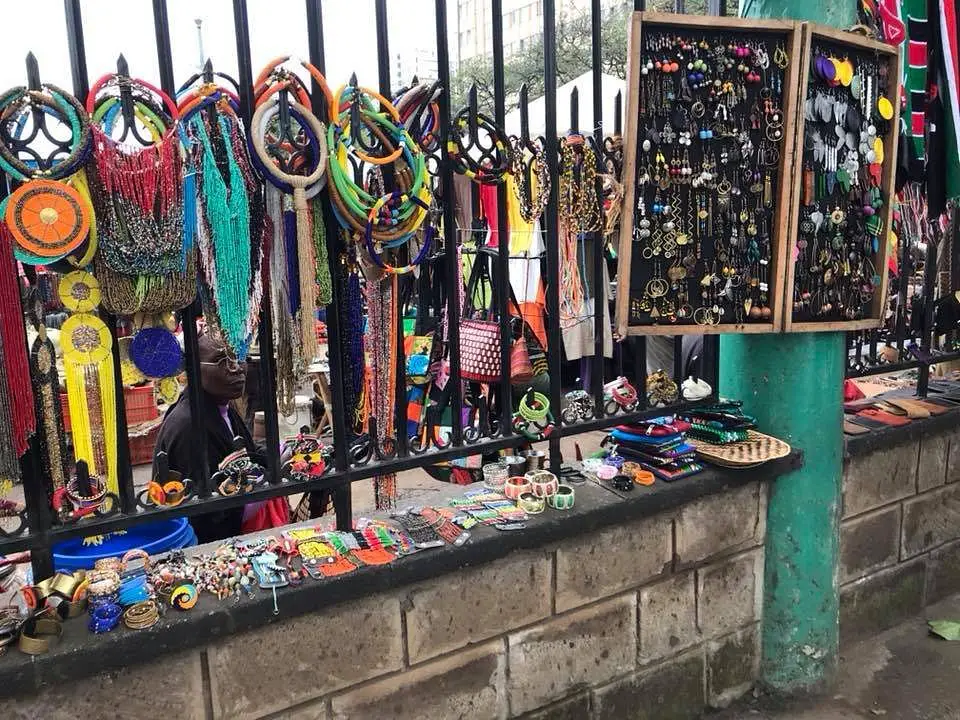
The Maasai Market is a vibrant open-air market in Nairobi, renowned for its wide array of traditional Kenyan crafts, jewelry, and artifacts. This colorful and bustling market is named after the Maasai people, one of Kenya’s most famous tribes, known for their distinctive customs, dress, and vibrant beadwork.
Visitors to the Maasai Market have the opportunity to immerse themselves in a sensory-rich environment filled with bright colors, enticing scents, and the captivating chatter of traders. The market offers an extensive selection of handmade items, including traditional Maasai beadwork, carved wooden sculptures, batik wall hangings, soapstone carvings, paintings, fabric, clothing, and much more.
Each item sold at the market is crafted by Kenyan artisans, providing visitors with an authentic piece of Kenyan culture. The market is a significant source of income for many local craftsmen and women, making your purchases an excellent way to support the local economy.
One of the unique aspects of the Maasai Market is that it rotates locations throughout the week, setting up in different parts of Nairobi on different days. This allows a broad range of locals and tourists alike to have access to the market.
The market is renowned for its lively haggling culture, with friendly negotiation being a common part of the shopping process. It’s a good idea to prepare for this in advance and embrace the experience as part of the local culture. Bargaining is not just about getting a good price but also about building rapport with the sellers.
In addition to shopping, visitors to the market can often see artisans at work, providing a first-hand look at the incredible skill and craftsmanship that goes into each item.
A visit to the Maasai Market in Nairobi offers a unique shopping experience, steeped in culture and tradition. It’s an excellent place to find unique souvenirs and gifts, all while supporting local artisans and experiencing an integral part of Nairobi’s lively market culture.
Karura Forest
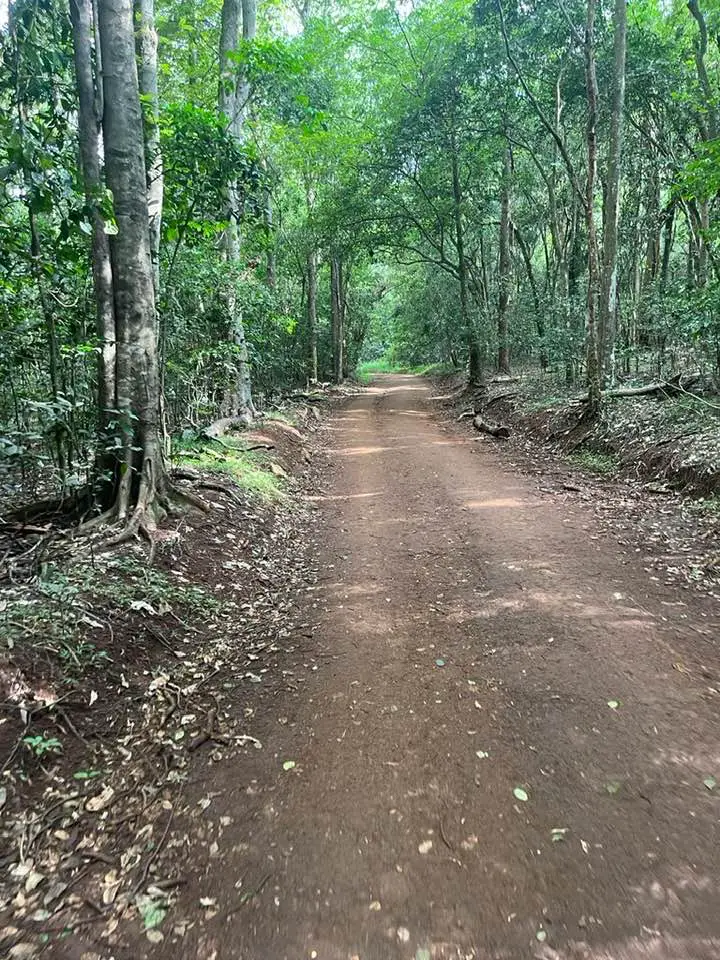
Karura Forest is an urban oasis situated in the heart of Nairobi, Kenya. Covering an expansive area of over 1,000 hectares, it is one of the largest urban gazetted forests in the world. The forest was formally gazetted in 1932 and has since been a significant asset for Nairobi’s environmental conservation efforts.
Karura Forest offers a sanctuary from the bustling city life, with its serene walking trails, waterfalls, picnic spots, and diverse wildlife. Its dense tree canopy provides a haven for various bird species, insects, and small mammals, including monkeys. It’s a great place for bird watchers and nature lovers.
One of the forest’s main attractions is its scenic waterfall and caves. The Mau Mau Caves hold historical significance as they were used by Kenyan freedom fighters during the struggle for independence in the 1950s.
The forest also features a Bamboo Forest, wetlands, and the River Cafe, an idyllic eatery nestled within the forest where visitors can enjoy a meal in a tranquil setting.
Karura Forest is a popular spot for outdoor activities such as walking, jogging, biking, and even forest yoga. The forest management has provided well-marked paths, making it a safe and pleasant environment for these activities. Bike rentals are available for those who wish to explore the forest on two wheels.
The forest is managed by the Friends of Karura Forest Community Forest Association in partnership with the Kenya Forest Service. Over the years, successful reforestation efforts have been made to replenish areas that had been degraded due to illegal activities.
Karura Forest is a shining example of successful community-led conservation efforts. It serves as a critical green lung for Nairobi, offering residents and visitors alike a serene environment to relax, unwind, and appreciate nature’s beauty.
Visiting Karura Forest is not just a great way to explore the natural beauty of Kenya without leaving the city, but also an opportunity to support local conservation efforts, making it a must-visit for anyone visiting Nairobi.
Nairobi Railway Museum

The Nairobi Railway Museum is a remarkable attraction situated near Nairobi’s city center, offering a unique glimpse into Kenya’s railway history and its profound impact on the country’s development. It is located adjacent to the Nairobi Railway Station and was opened in 1971 by the East African Railways and Harbours Corporation to preserve and display the history of rail travel in East Africa.
The museum exhibits an impressive collection of vintage trains, carriages, and equipment, some dating back to the late 19th and early 20th centuries. These artifacts offer insights into the technological advancements in railway transportation over the years.
One of the museum’s highlights is the collection of vintage steam locomotives, some of which are over a century old. Visitors can even explore inside some of these trains, offering a real sense of what rail travel was like during that era.
The museum houses several historically significant carriages, including the carriage from which Superintendent Charles Ryall was taken by a man-eating lion at Kima Station in 1900, and a carriage used by His Highness the Aga Khan during his East African tours.
In addition to the train exhibits, the museum features an extensive photographic collection, models, and small exhibits that narrate the story of the railway’s construction and its influence on Kenya’s development. The railway’s construction, famously known as the “Lunatic Express,” connected the port of Mombasa to Lake Victoria, leading to the founding of Nairobi and significantly shaping Kenya’s economic, social, and political landscape.
The museum also documents the challenges encountered during the railway’s construction, including difficult terrain, diseases, and attacks from wildlife, notably the man-eating lions of Tsavo, which halted construction for several months.
The Nairobi Railway Museum serves as a vital repository of East African railway history and offers a fascinating experience for history enthusiasts, train lovers, or anyone interested in understanding Kenya’s historical context. A visit to the museum is a journey back in time, offering a unique perspective on Kenya’s colonial era and the advent of modern transportation in the country.
Nairobi’s Historic City Centre
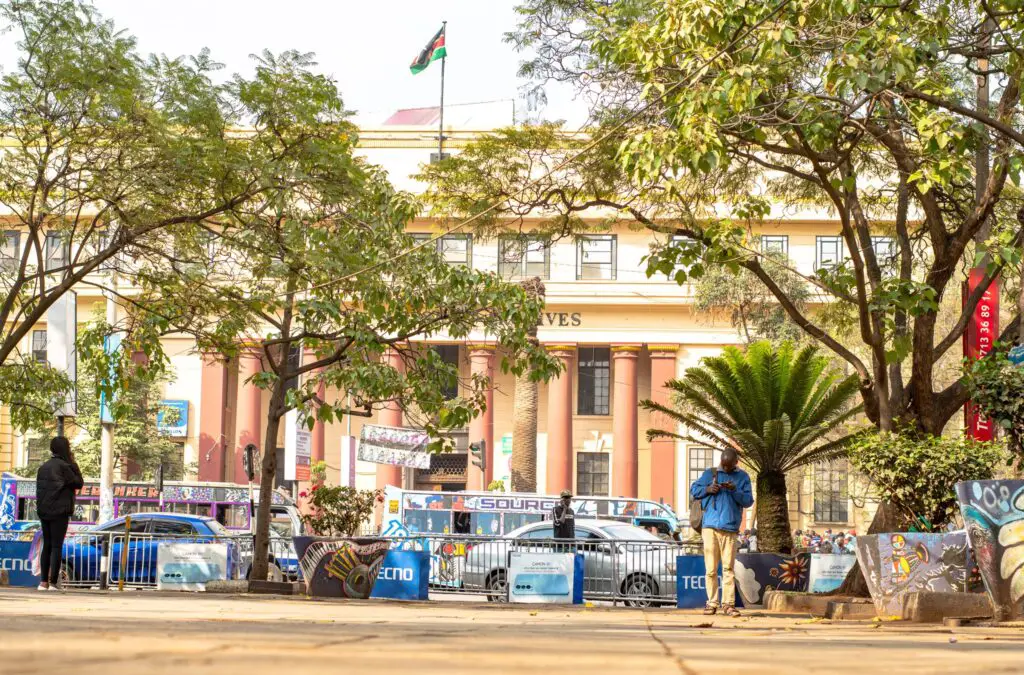
Nairobi’s historic city center is a vibrant and bustling area, offering a rich blend of Kenya’s history, culture, and modern urban life. The city center is well laid out, with most historical landmarks and important buildings within walking distance of each other.
One of the city center’s most iconic landmarks is the Kenyatta International Convention Centre (KICC). It’s one of the tallest buildings in Nairobi, offering a 360-degree panoramic view of the city from its rooftop. The building has been a central hub for conferences and exhibitions since the 1970s.
Another notable historical site is the City Hall, which houses the city’s county government offices. This colonial-era building showcases British architectural influences and is an integral part of Nairobi’s political history.
The Nairobi National Archives, located at the edge of the city center, houses an extensive collection of artifacts, documents, photographs, and artworks that depict Kenya’s cultural and historical heritage. The building itself, with its distinctive architectural design, is a significant landmark in the city.
The city center is also home to Jeevanjee Gardens, a public park established in the late 19th century by Alibhai Mulla Jeevanjee, an Asian Kenyan entrepreneur. The park, a green oasis amid the city’s hustle and bustle, serves as a popular gathering spot for city dwellers and hosts various cultural events.
The city center also hosts several markets, including the City Market, a large covered market where one can buy everything from fresh produce, meat, and fish, to flowers, art, and curios. The Maasai Market, a colorful open-air market selling Maasai crafts and jewelry, is also a popular attraction.
Visiting Nairobi’s historic city center offers a unique opportunity to experience Kenya’s vibrant urban life, soak in the city’s history, and interact with its diverse cultures. Whether you are a history buff, a food lover, or an enthusiastic shopper, the city center has something to offer for everyone.
Nairobi Arboretum

The Nairobi Arboretum is a tranquil haven located just a short distance from the city’s bustling center. Spanning an impressive 30 hectares, this beautiful park is home to over 350 species of native and exotic plants, making it a paradise for nature enthusiasts, botanists, and bird watchers.
The Nairobi Arboretum was established in 1907 by Mr. Batiscombe, then Deputy Conservator of Forests, who requested a reserve be set aside for trial and experimentation of forestry species. This area, initially just four hectares, grew into the arboretum we know today, now managed by the Kenya Forest Service in collaboration with the Friends of Nairobi Arboretum (FONA).
The arboretum is organized into several thematic sections, including the bamboo garden, palm garden, and the medicinal plants garden, among others. The diversity of tree species creates a vibrant ecosystem that supports a rich bird life, with over 100 species of birds recorded in the area.
The arboretum provides a serene environment perfect for recreational activities. Visitors can enjoy a peaceful walk along the well-maintained nature trails, have a picnic, engage in physical activities such as jogging or yoga, or simply sit and enjoy the tranquility. The arboretum also has a designated children’s area, making it a great destination for family outings.
For those interested in learning, the arboretum provides educational programs focused on environmental conservation. It also hosts various events throughout the year, including tree planting, bird watching, and nature walks, further promoting environmental awareness.
The arboretum is also a center for research, providing valuable data on tree species performance, ecological succession, and urban pollution, among other things.
The Nairobi Arboretum is not only a sanctuary for plants and wildlife but also a breath of fresh air for city dwellers and visitors. Its beautiful landscapes and tranquil ambiance offer a respite from the hustle and bustle of the city, making it an ideal spot for relaxation, recreation, and the appreciation of nature’s beauty.


